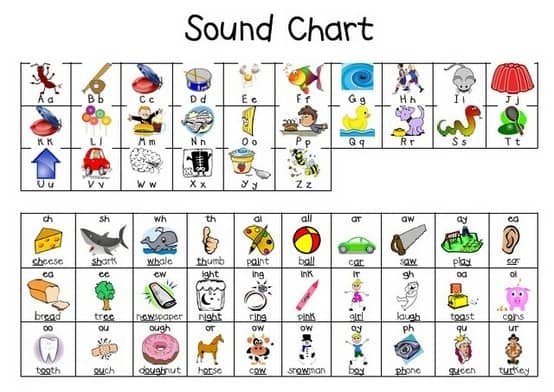
While phonics is the skill of knowing the sounds made by letters in the alphabet, phonemic awareness is the skill of identifying sounds and where they are located - at the beginning, middle or end of a word.
Listeners should be able to hear, identify and manipulate phonemes, the smallest units of sound that can differentiate meaning. Separating the spoken word "cat" into three distinct phonemes, /k/, /æ/, and /t/, requires phonemic awareness.
Phonemic awareness activities in pre-school and kindergarten focus on simple tasks such as rhyming, matching words with beginning sounds, and blending sounds into words. Later, students move onto the addition, subtraction and substitution of phonemes to learn how words change.
Ways in which students learn phonemic awareness are through activities that may require them to:
Match words by sounds;
Isolate a sound in a word;
Blend individual sounds to form a word;
Substitute sounds in a word;
Segment a word into its sound parts.
Here are some activities you can do with your budding reader to engage them in phonemic awareness:
Sound matching activities
One of the easier phonemic awareness activities is matching sounds.
Select pictures of familiar objects, such as a flower, fruit and ferry, cat, car and clown. Paste them in a word document, and cut them out as cards. Mix up the pictures and have your child pick out the cards that start with the same sound, say /f/.
Sound isolation activities
In sound matching kids are asked to identify an individual sound. In sound isolation activities they are asked the reverse – they’re given a word and asked to tell what sound is at the beginning, middle or end of a word.
One activity you can do is to help isolate sounds is to sing. To the tune of ‘Old MacDonald Had a Farm’.
Pick three words that start with the same sound, say: fan, fox and freeze.
Here are the lyrics:
“What’s the sound that starts these words:
Fan, fox and freeze.
(Wait for the response from your child.)
/f/ is the sound that starts these words:
Fan, fox and freeze.
With an /f/, /f/ here and an /f/, /f/ there.
Here an /f/, there an /f/, everywhere an /f/, /f/.
/f/ is the sound that starts these words:
Fan, fox and freeze.”
You can do the same for identifying middle and end sounds.
Here’s one for middle sounds:
The words are cat, hat and mat.
“What’s the sound in the middle of these words:
Cat, hat and mat.
(Wait for the response from your child.)
/ æ/ is the sound in the middle of these words:
Cat, hat and mat.
With an / æ/, / æ/ here and an / æ/, / æ/ there.
Here an / æ/, there an / æ/, everywhere an / æ/, / æ/.
/ æ/ is the sound in the middle of these words:
Cat, hat and mat.”
Blending activities
Blending requires your child to use individual sounds by combining them to make a word.
For example: /k/ - /a/ - /t/ - cat
An activity you can do with your child is to play: what am I thinking of? Tell your child you are thinking of an object in a specific category. For example: I’m thinking of an animal. You’ll then tell your child the separate sounds in the word.
For example: /b/ - pause - /a/ - pause /t/
Your child must then blend the sounds together to make the word – bat.
Addition and substitution activities
In adding and substituting sounds in words in familiar songs, your child will learn to focus on the sounds that make up speech.
For example, take the Happy Birthday song. Substituting the initial sound with a /b/ throughout, you would sing:
“Babby birthday bo bou
Babby birthday bo bou
Babby birthday bo Brianna (or insert your child’s name with a substituted first letter B. For example, if your child’s name is Tim, he would be Bim)
Babby birthday bo bou.”
Segmentation activities
Segmenting means the act of isolating sounds in a spoken word.
Segmenting the sounds in a word is the hardest of all phonemic awareness tasks. It’s is critical, though, for your child to learn as it relates to their later success in decoding words when learning to read.
You’ll want to start with segmenting the sound at the beginning of a spoken word.
One activity you can do to teach segmentation is to use flashcards with pictures of familiar objects, such as animals, vehicles, kitchen items, etc. For each picture, have your child exaggerate – or elongate – the first sound of each picture.
If the picture is of a dog, your child would say d-d-d-d-og. And then ask them what that first sound was and have them repeat /d/.
Once your child has mastered the first sound, move onto the middle sounds and later the ending sound. Finally you’ll want to have them sound out the entire word - /d/ /o/ /g/.

